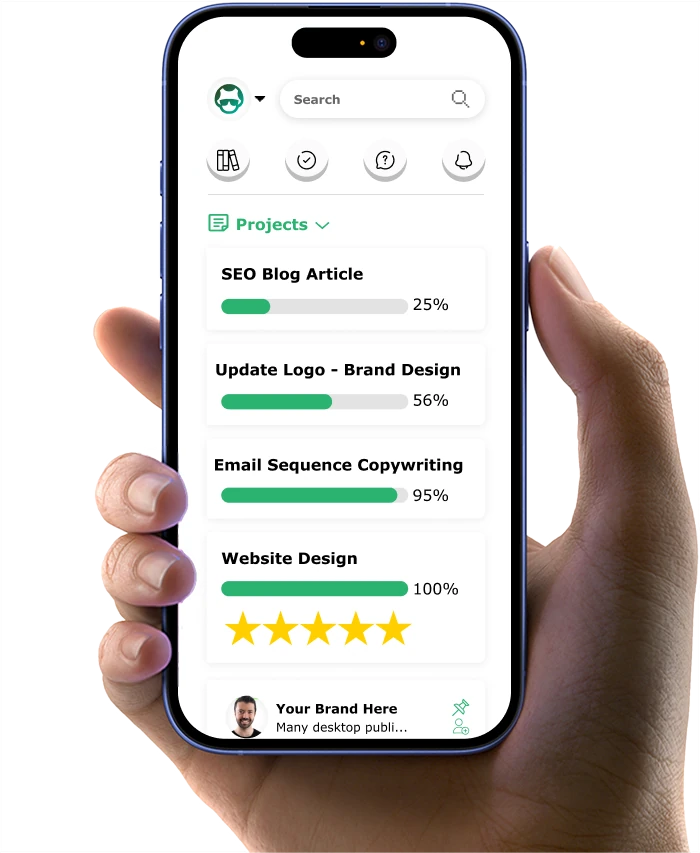How to Get 50% Increase in Leads w/ 1 Line of Text (Copy It - Actionable Example)
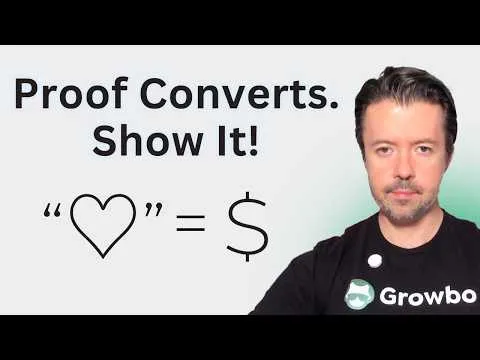
Generating leads online is more challenging than ever. Search traffic is down, ad costs are up, and the old marketing tricks just aren't working anymore.
To watch your website visitors slip away it’s frustrating (I understand, trust me). But it’s especially vexing when you know your product or service delivers real value.
But the thing is: you don't need to rebuild your entire site or spend a fortune on new tools. Sometimes, the answer is a single, smart change right where it matters most.
Let me tell you about a high-end hospitality school in Switzerland. Despite their reputation and world-class programs, they struggled to get visitors to convert on a lead form. The marketing team tried shortening fields, changing colors, even redesigning the page.
Nothing worked.
Then, with one simple adjustment, everything changed. The A/B test showed that now 50% more prospects were filling out the form and reaching out.
Today’s video + article breaks down this proven tactic to help you capture more leads on your website—right when your prospects are making up their minds.
(Note: when you read what the tactic is, if you’re a bit cynical like me, you might be tempted to say, oh that’s so simple… but trust me, there are deeper insights here)
What you'll get:
- Exactly what to say (and where to say it) to stop form abandonment at the critical moment
- The “human” authenticity principle that makes prospects trust you instantly — and the mistakes that destroy it
- The exact one-line testimonial placement strategy that increased lead submissions by 50%—and why it works at the "zero moment of truth"
Want to delegate all your marketing and funnel work done—without the headaches of hiring ? Download our free guide: 33 Marketing Projects You Can Delegate to Growbo and discover how to save 100+ hours a month, grow faster, and scale without the overhead.
Why Lead Generation Is Critical Right Now
If you're generating leads for your business, if you're a service business, or if your clients sell services, you know how critical it is that you generate a consistent and steady flow of leads.
It takes time for each lead once the form is submitted to be nurtured, to get on the phone, to follow up, and then ultimately to close and to turn into revenue and profit for the business.
Continuous lead flow is critical, and today especially with the current state of digital marketing. According to Wiserreview, regularly adding customer testimonials to your product or landing pages can boost annual revenue by up to 62%—proof that small optimizations in your lead generation process can have massive compound effects over time.
The Google Traffic Problem…
Google search traffic has dropped for almost all websites—between 50% to 80%—because of AI updates, Google putting AI overviews at the top of searches, and tools like ChatGPT taking market share.
As Google continues rolling out its own AI mode, it's gradually taking over the search experience. This means traffic has dropped significantly, and it may continue to do so.
For most businesses, this is a real problem. Cost per click is going up. Your other options include turning to social media organic channels (which you may already be doing), pay-per-click search ads, or advertising on other miscellaneous sources like Reddit.
The challenge: It takes time and a significant chunk of money to figure out how to get those ads to work, especially if you're just starting out. For example, on LinkedIn, you're going to burn at least $5,000 to $10,000 before you figure out your customer acquisition cost—unless you get lucky or you're working with someone who really knows what they're doing.
The Solution: Optimize Your Existing Funnel Instead of Chasing New Traffic
Your other options include turning to social media organic channels (which you may already be doing), pay-per-click search ads, or advertising on miscellaneous sources like Reddit. The challenge: it takes time and a significant chunk of money to figure out how to get those ads to work.
On LinkedIn alone, you're going to burn at least $5,000 to $10,000 before you figure out your customer acquisition cost—unless you get lucky or you're working with someone who really knows what they're doing.
The smarter option? Focus on your funnel, on your website, and optimize the hell out of it.
Even if your traffic dropped—let's say your search traffic dropped 50% overall but net traffic only dropped 30%—that can impact your business by a 30% drop in revenue. The way that you can make up for it is by optimizing your existing website and overall sales funnel by making small tweaks like what I'm about to show you here.
The chart below illustrates just how significant site performance can be. As load time increases, conversion rates drop steeply—especially beyond the 3–4 second mark.
In fact, even a few seconds' delay can cut conversions in half. This data underscores why site optimization isn't just about user experience—it's about business performance.
A faster, smoother site directly improves your conversion outcomes and overall funnel efficiency.
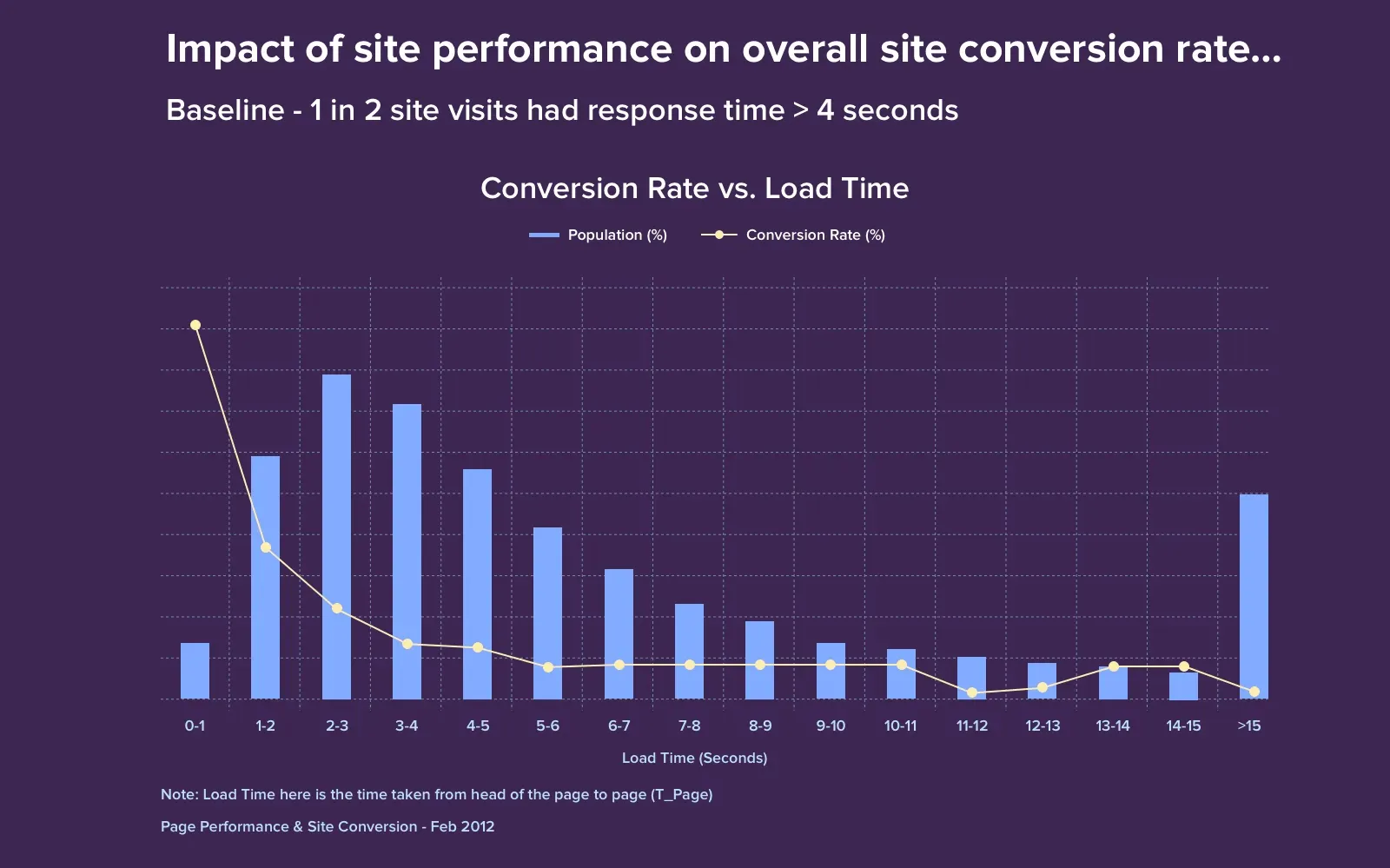
It's more doable than you think to achieve a 30% increase and even a 50% or even 100% increase over time. It comes from these little incremental wins, and it comes honestly just from empathizing and understanding what works, why it works, and the context and mental and emotional space that your prospective customers or clients are in.
The Real-World Case Study: Hotel Institute Montreux
Hotel Institute Montreux is a prestigious Swiss hospitality school with a global reputation for excellence. Despite their world-class programs and strong brand recognition, they faced a frustrating lead generation problem that was holding back their growth.
This tactic in the case study is highly relevant across industries and business models because when you test this on your own site, there's a strong chance you'll see positive results too. Whether it's 50% increase in lead form submissions (which is worth it for just about anyone) or even just a 5-10% increase, that's still substantial and stacks up over time in terms of net increase in overall leads and revenue generated.
The Problem They Faced
The Hotel Institute Montreux had a lead generation problem. Their programs were world-class, but the inquiry form had terrible completion rates. Prospective students would start filling it out on their website, but then abandon it.
What They Tried (That Didn't Work)
The drop-off rate was significant enough to impact their enrollment pipeline. Their internal team tried multiple approaches:
- Redesigning the form
- Removing form fields to reduce friction
- Changing colors
- Multiple rounds of testing
The strategy of removing form fields, in particular, is related to one of the 11 laws of sales funnel physics (our proprietary framework at Growbo)—specifically the Law of Friction.. The principle is sound: usually, when you remove form fields, conversions increase because there's less work required from the prospect.
However, there's a downside: oftentimes the quality of leads goes down because you're not pre-qualifying them as much. Maybe they were getting more leads, but those leads weren't converting to customers.
The One-Line Tactic That Changed Everything
Here's what they did, and it's remarkably straightforward.
The Hotel Institute Montreux ran a test where they placed a single testimonial directly above the lead generation form on the same page. Not on a previous page, not buried somewhere else on the site, but right there in the critical moment where prospects were deciding whether to commit.
The One-Line Tactic That Changed Everything
Here's what they did, and it's remarkably straightforward.
The Hotel Institute Montreux ran a test where they placed a single testimonial directly above the lead generation form on the same page. Not on a previous page, not buried somewhere else on the site, but right there in the critical moment where prospects were deciding whether to commit.
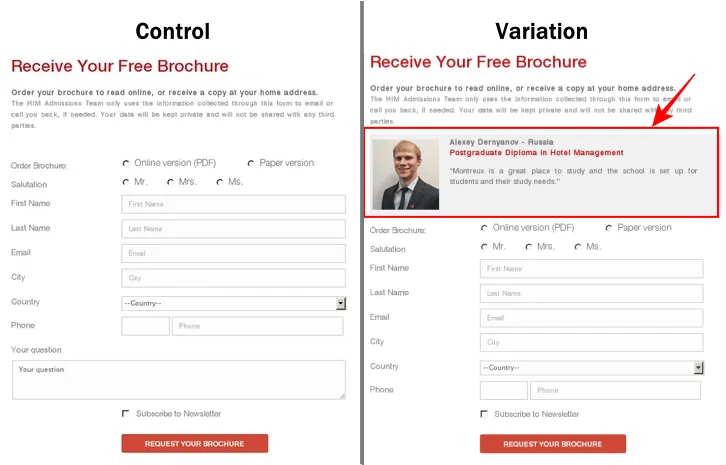
The Result: A 50% Increase
This simple change resulted in a 50% increase in lead form submissions.
When you looked at the data comparing the original page to the new version with the testimonial, the difference was unmistakable and statistically significant.
Why This Testimonial Tactic Works
Let me break down the psychological and strategic principles behind why this simple change made such a huge difference. Understanding the "why" is crucial because it allows you to adapt this approach intelligently to your own situation.
What Was Actually Added
First, consider what was actually added: just one line of text paired with an authentic image. Nothing elaborate, no fancy design tricks, no expensive production.
The testimonial itself was straightforward and genuine:
"Montreux is a great place to study and the school is set up for students and their study needs." Accompanying this quote was the student's full name, where he's from, and what diploma he's pursuing. These details absolutely matter—they add critical credibility and specificity that generic testimonials simply cannot provide.
The results were dramatic: this simple change resulted in a 50% increase in lead form submissions. When you looked at the data comparing the original page to the new version with the testimonial, the difference was unmistakable and statistically significant.
Principle #1: Social Proof (The Law of Proof)
At its core, this is social proof—a concept that's a fundamental part of our 11 laws framework, specifically the Law of Proof. Social proof works because humans are inherently social creatures who look to others' experiences when making decisions, especially in situations involving uncertainty.
It builds credibility in a way that your own marketing claims simply cannot. Whether it's a testimonial like this one or a five-star review, social proof from real people carries weight.
Just look at the data in the next image — customers who interact with a review are 58% more likely to convert, and having 50 or more reviews can lift conversion rates by 4.6%.
That’s the measurable impact of social proof in action. It’s not just a nice-to-have; it’s a proven conversion lever that reduces doubt and builds trust where it matters most.
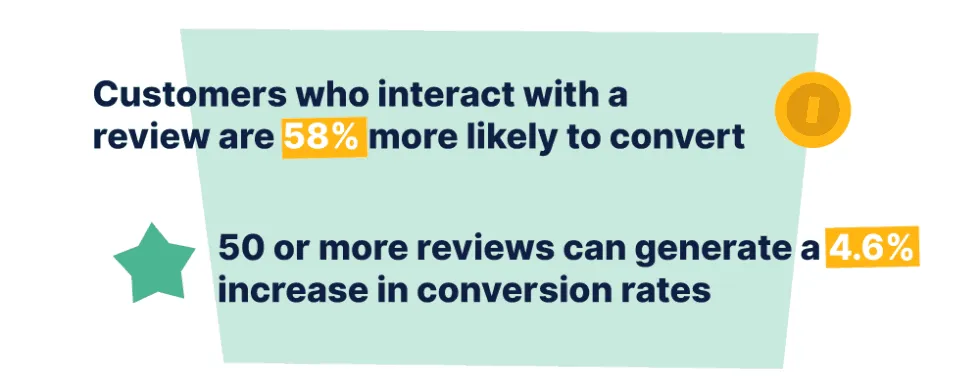
Principle #2: Future Pacing
But there's something deeper happening here too, and it's called future pacing. When a prospect is on this page, they're standing at what I call a moment of truth.
Filling out that form represents a soft commitment—they're not buying anything yet, but they are committing to receive information and to be marketed to. That requires a certain level of comfort and confidence.
Future pacing works by helping prospects imagine themselves after making the decision, feeling happy and affirmed about their choice. The testimonial essentially tells them, "Here's someone who was once in your shoes, who made this decision, and who is now satisfied with the outcome."
What prospects truly want in this moment is the confidence that they'll feel no regret, no buyer's remorse after taking this step. They want to know that when they look back on this decision—whether it's a day from now, a week from now, or even months from now—they'll be glad they filled out that form.
This testimonial provides exactly that reassurance, directly addressing the fear of making the wrong choice.
In this case, the message was: "Montreux is a great place to study and the school is set up for students and their study needs." No regret, no buyer's remorse.
We all carry an innate desire to have our decisions affirmed and to minimize perceived risk. This testimonial provides that affirmation at exactly the moment it's needed most.
Principle #3: Authenticity Matters
Authenticity isn't just a nice-to-have in this equation—it's critical to the entire approach working effectively.
The testimonial in this case was paired with a genuine photo of an actual student. Not a professional model with perfect lighting and styling, not a polished stock photo pulled from a generic image database. A real student, in a suit and tie, looking like an ordinary young person pursuing their education.
- DO use: Real customer photos, natural images, authentic headshots
- DON'T use: Stock photos, professional models, overly polished images
Why it matters: When website visitors see an obviously fake or generic testimonial paired with a stock photo, their bullshit detector goes off immediately. They've been conditioned by years of internet marketing to recognize inauthenticity, and when they see it, trust evaporates instantly.
The data in the following chart reinforces this point. Images and videos from real customers (user-generated content) are trusted by 33% of consumers, making them the most credible form of visual content. In contrast, professionally shot visuals rank at 24%, while AI-generated and stock imagery lag far behind at 16% and 8%, respectively. The numbers are clear—authentic, real-world visuals outperform artificial ones in building customer trust and ultimately driving conversions.
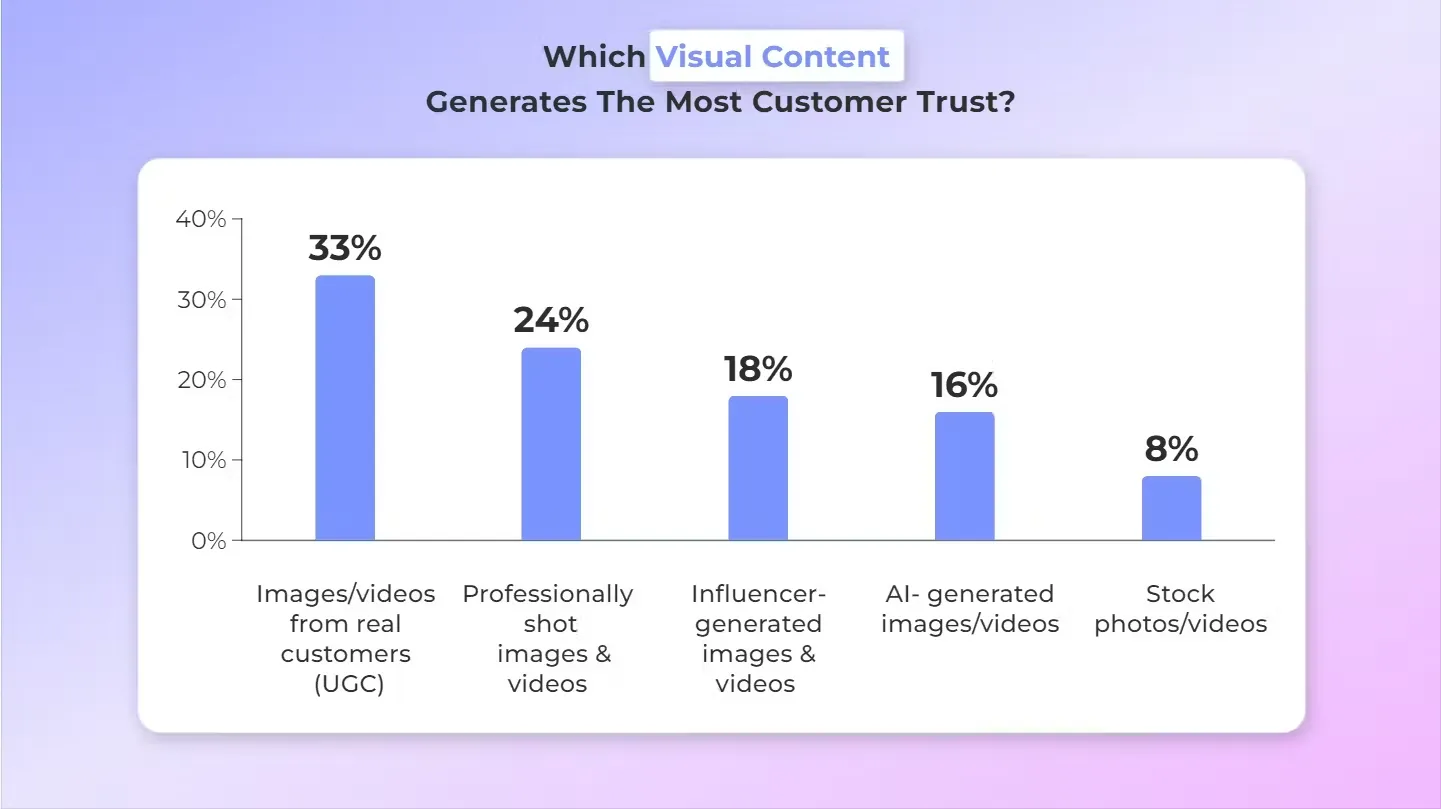
In the Hotel Institute Montreux example, the photo works precisely because it looks human. It's not perfect—the student isn't a model, the photo isn't professionally retouched to perfection.
And paradoxically, that imperfection makes it more believable and more persuasive. It signals authenticity, and authenticity builds trust.
Principle #4: Strategic Placement (The "Zero Moment of Truth")
The placement of this testimonial also matters tremendously. This wasn't placed randomly somewhere in the funnel or buried at the bottom of a previous page.
It was positioned right there, directly above the form on the exact page where the action happens. This is what's known as the "zero moment of truth"—the precise instant when a prospect makes their decision.
Think about it from a timing and cognitive perspective: If you show social proof earlier in the funnel, it might build some initial trust, but by the time prospects reach the actual commitment point, that impact has faded. Their attention has moved on, they're focused on the form itself, and the psychological boost from that earlier social proof has dissipated.
Studies show that regularly adding customer testimonials to your product or landing pages can boost annual revenue by up to 62%. That's a huge lift from such a small change.
It's proof that thoughtful placement isn't just good design—it's smart psychology in action. When trust and timing line up, conversion happens almost naturally.
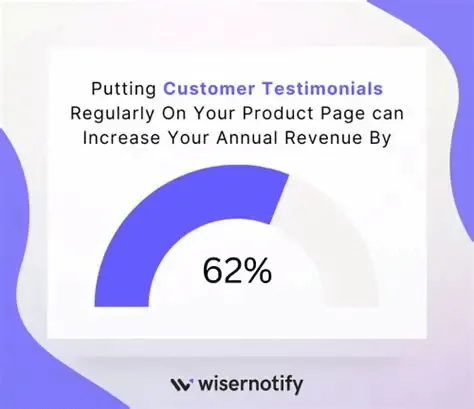
Consider the alternative: if the Hotel Institute Montreux had placed this same testimonial on the previous page in the funnel, it almost certainly wouldn't have worked as well. By the time prospects reached the form page, they might have forgotten about it, or its impact would have faded.
The further away social proof is from the decision point, the less effective it becomes.
The winning formula: The testimonial needs to be highly visible, genuinely authentic, and elegantly simple. Complexity dilutes impact, while simplicity paired with strategic placement amplifies it.
How to Apply This Tactic in Your Business (Step-by-Step)
Now let's break down exactly how you can implement this in your own business. It's pretty straightforward—you can model this example directly.
Step 1: Identify Your "Zero Moment of Truth"
Find where in your funnel prospects make their commitment decision.
For most businesses, this is:
- The page with your lead generation form
- Your checkout page (if you have a productized service)
- Your contact/quote request form
- Your consultation booking page
This is where your testimonial needs to live—not on a previous page, but right there at the decision point.
At Growbo, we practice what we preach. We have social proof on our checkout page, and it has incrementally helped us to convert more clients and gain more signups.
Step 2: Select the Right Testimonial
You need to strategically choose a testimonial or review that does what the Hotel Institute Montreux example does. It's future pacing—it's kind of like: "After I fill out this form, maybe a day, a week, even months from now, what do I want to be thinking? What do I want to be feeling?"
Your testimonial should: ✓ Address the prospect's main hesitation or concern ✓ Use future pacing language (imagining life after the decision) ✓ Mention specific outcomes: ROI, time saved, or the specific problem that was solved ✓ Directly relate to your core value proposition as you've advertised it on your website ✓ Feel authentic and genuine
Testimonial Template Option 1:
"Before I submitted this form, I wasn't sure if [your service/product] was worth it, but it was the best decision I ever made." — [Name], [Title/Location/Company]
Testimonial Template Option 2:
"[Your company/product] is a great [place/solution] and [specific benefit that addresses their main concern]." — [Name], [Relevant Credential]
Important: Include relevant identifying details like the person's name, title, or location—but only if those details are meaningful to your target audience.
Examples:
- If you're selling to C-level executives → include their title (CEO, CMO, etc.)
- If you're selling local services → include their city or neighborhood
- If you're in B2B → include their company name
- If credibility comes from credentials → include their diploma, certification, or degree
Step 3: Pair It with an Authentic Photo
Use a genuine photo of the actual customer who gave the testimonial.
✓ Real customer photos
✓ Natural, unposed images
✓ Professional but authentic headshots
✓ Photos that look like real people
❌ Stock photos
❌ Professional models
❌ Overly polished or staged images
❌ Generic silhouettes or placeholders
Step 4: Place It at the Decision Point
Position your testimonial:
- Directly above your form (most effective)
- Next to your form if layout permits
- On the same page as the form—never on a previous page
Placement matters because you're catching prospects at their zero moment of truth—the precise instant when they're deciding whether to commit.
Step 5: Keep the Design Simple
Format: Simple testimonial or five-star review, highly visible, authentic, and simple.
Design guidelines:
- Clean, uncluttered layout
- Visually distinct but not distracting
- Readable and scannable
- No fancy design tricks
- Let the words and authentic photo do the work
Remember: Just one line of text paired with an authentic image. Nothing elaborate, no expensive production.
How to Test and Measure Your Results
One common misconception is that you need massive amounts of traffic to validate whether this tactic works for your business. That's simply not true.
Even if you don't have a ton of traffic where you can easily and quickly A/B test this, you still have options.
Understanding Statistical Significance
If you have enough traffic to run a statistically significant A/B test (meaning you can be 95% confident or more that the results aren't due to chance), then absolutely run a proper split test. Tools like Google Optimize, VWO, or Optimizely make this relatively straightforward.
However, if your traffic volume doesn't support that level of statistical rigor, don't let that stop you. You can still implement what's called a sequential test.
Simply document your baseline metrics—your current conversion rate over a specific time period—then implement the change and monitor whether your stats improve meaningfully afterward.
If you see any consistent, meaningful improvement over a reasonable time frame (typically at least a few weeks to account for normal fluctuation), that's a win worth keeping. You don't need perfect statistical significance to make good business decisions, especially when the downside risk is minimal and the implementation cost is low.
The probability that this tactic will work for you—even if only incrementally—is quite good, provided you follow the core principles I've discussed: authenticity, strategic placement, and alignment with your visitors' mindset and needs.
Small Tweaks, Big Results
Here's a broader truth that this case study illustrates perfectly: big improvements in marketing performance often come from small, thoughtful tweaks rather than massive overhauls.
Too many businesses get paralyzed thinking they need to completely rebuild their website, invest tens of thousands in a rebrand, or implement complex marketing automation before they can see meaningful improvements. While those larger initiatives have their place, they're not always where the highest ROI opportunities lie.
The Hotel Institute Montreux's 50% increase didn't come from a six-month redesign project or a six-figure consulting engagement. It came from adding one testimonial in the right place.
The real skill in optimization is empathy—genuinely understanding your prospects' mindset when they're standing at that critical moment before they submit your form.
What are they thinking? What are they worried about? What would give them confidence? What would affirm that they're making a smart decision?
When you can answer those questions accurately, you can deploy targeted solutions like strategic social proof that reduce perceived risk and affirm the decision they're about to make. That's how small tweaks create surprisingly big results.
Conclusion
Want to delegate all your marketing and funnel work done—without the headaches of hiring ? Download our free guide: 33 Marketing Projects You Can Delegate to Growbo and discover how to save 100+ hours a month, grow faster, and scale without the overhead.
Placing an authentic testimonial directly above your lead form can increase submissions by 50%. This simple tactic is based on proven psychological principles: the Law of Proof (social proof) combined with future pacing to eliminate buyer's remorse at the exact moment prospects make their decision.
The Hotel Institute Montreux's success didn't come from a six-month redesign or six-figure consulting engagement. It came from adding one testimonial in the right place.
That's the power of small, strategic tweaks when you understand your prospects' mindset at their moment of truth.
Ready to implement this and other high-impact tactics? If you want help finding these optimization opportunities—or if you're ready to delegate all your digital marketing tasks without the headaches of hiring—check out Growbo.com.
Growbo offers an all-in-one marketing fulfillment team with 13 skills: copywriting, design, development, graphic and web design, app management (Go High Level or any CRM), project management, ads management, and social media. We provide templates for over 100 proven tasks, all for less than the cost of one virtual assistant, with a 14-day money-back guarantee.
Want to see what else you can delegate? Opt in to get the free PDF: 33 Marketing Projects You Can Delegate to Growbo. You'll discover specific examples of tasks that save 100+ hours a month and help you scale faster.
And remember, sometimes one line of text can make all the difference.
Keep Growing, Stay Focused,
Image Credits:
1. https://www.cleveroad.com/blog/these-9-website-performance-optimization-techniques-will-help-you-speed-up-your-website/
2-3. https://vwo.com/success-stories/hotel-institute-montreux/
4. https://www.wyzowl.com/why-testimonials-are-important/
5. https://explodingtopics.com/blog/social-proof-stats
6. https://wisernotify.com/blog/testimonial-stats/



